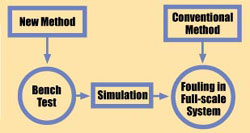|
by Jessica Loon

 ingapore, a nation lacking its own freshwater resources, has been investigating water reclamation technologies for some time. ingapore, a nation lacking its own freshwater resources, has been investigating water reclamation technologies for some time.
At the National University of Singapore, the Water and Biotreatment Group (WBG) has been actively conducting research and development in water reclamation since the late 1980s. As the anchor R&D group of the new Centre for Water Research (WRC) hosted by the Department of Civil Engineering, WBG has developed several versions of membrane-based water-reclamation systems capable of delivering product water suitable for high-value reuse application.
"Membrane technology is an emerging technology. In probably a couple of years' time, it will overtake the conventional method as it is able to save on land use in the urban area," says Associate Professor Ong Say Leong who heads the WRC. "It is one of the areas we are now seriously working on. In the past, we focused more effort on wastewater treatment. However, [fresh] water has become so important that the group has decided to place a greater emphasis on this area."
The group actually works in three major areas. The first focuses on quality enhancement of water and treated wastewater to meet Singapore's internal demand for both potable and non-potable water. The second looks at desalination, using the distillation process and membrane technology. The third centres on the biotechnology that complements the first two areas of research.
"Another exciting research programme we are working hard at is ways to prevent biofouling (the undesirable accumulation of microorganisms) on membrane surface," Ong adds. "The challenge now is to work out the operating protocol that will prevent biofouling. Our role is to maximise the performance of the membrane."
Biofouling reduction currently constitutes a hot research topic. When biofouling occurs, performance of the reverse osmosis (RO) membranes deteriorates. For potable water treatment, the type of membrane used is generally an ultra-thin polyamide layer with pore size of less than 0.001µm. Over 98% of dissolved salts, organic particles, microorganisms and other nutrients can be detained. However, this process also leads to the attachment, accumulation, and growth of microorganisms on the membrane surface. Once formed, this biofilm acts as a trap for other particulate matter, which can quickly build up into a dense biomass.
Planktonic water analysis and visual inspection of filters make up two traditional methods of monitoring and detecting the development of biofilms in RO systems. Other indicators include an increase in pressure differential across the plant, declining membrane flux, a drop in the percentage of salt rejection, physical evidence of a slimy coating on the cartridge filters, and high planktonic bacterial counts in the feed water.
"Prior to entering an RO membrane process, water is usually pre-treated to remove possible fouling agents. The pre-treatment methods include coagulation, sedimentation, filtration, and/or addition of anti-foulant to the feed water. However, there is a lack of an efficient method to assess or evaluate the effectiveness of pre-treatment needs. The commonly used pilot-scale test would take months or even years to produce some meaningful data over a single scenario," explains Dr Song Lianfa, an expert in membrane technology at WBG. "The WBG is actively pursuing the development of a quick characterisation method for studying membrane fouling in a full-scale RO process."
WBG is designing a modelling technique that can accurately simulate the performance of a full-scale RO water-treatment plant (Figure 1). If successful, it will provide the basis for further development of an innovative fouling-characterisation method, as well as pave the way for new water quality enhancement technologies.
 "The modelling technique is able to simulate the effects of the spatial variations of process parameters on system performance. When the local change in membrane resistance due to fouling is incorporated in the model, it will be able to predict the fouling development in the full-scale RO system," elaborates Song. "By referring to one point or a small segment of membrane in a filtration channel, the fouling rate should be identical or similar to that in the bench-scale (laboratory) membrane system, and therefore, can be determined from bench-scale experiment."
"The modelling technique is able to simulate the effects of the spatial variations of process parameters on system performance. When the local change in membrane resistance due to fouling is incorporated in the model, it will be able to predict the fouling development in the full-scale RO system," elaborates Song. "By referring to one point or a small segment of membrane in a filtration channel, the fouling rate should be identical or similar to that in the bench-scale (laboratory) membrane system, and therefore, can be determined from bench-scale experiment."
WBG is also studying the action of the membrane in hostile environments, such as extreme pH conditions and high organic contents. "This research emphasises ways to minimise the fouling potential - not to prevent it totally," says Ong.
Apart from the research by Song and Ong, which is nearing completion, WBG has also achieved considerable success in its development of the Sequencing Batch Reactor (SBR), the brainchild of Professor Ng Wun Jern, Dean of Engineering at NUS. The SBR records optimal performance when treating low- to medium-strength wastewater that has mainly dissolved organic substances.
Ng's spin-off company, Biotreat International Pte Ltd, has successfully marketed the SBR in ASEAN, Taiwan, China, and the Middle East. The product has been implemented successfully in plants on Jurong Island in Singapore, and at the new Kuala Lumpur International Airport in Malaysia. The engineers designed the processes to facilitate advanced biotreatment with nutrient removal, as well as water reclamation at the airport.
"The SBR is now being used in more than 100 plants in Asia and the Middle East," says Ong, who collaborates with Ng on this project. Although the research group based the commercial version on the first design, it is already at work on version 4 of the reactor.
A second product ready to be launched into the marketplace has been named the Anaerobic SBR. A joint project between NUS and the University of Toronto, it gets its funding from both Singapore's National Science and Technology Board and the Government of Ontario, Canada. "It is an improvement over the Aerobic SBR because of its lower operating costs. The system was designed with a radical change in the bioprocess environment, which results in air exclusion. Air inclusion, and hence its movement, is a major energy guzzler in the Aerobic SBR," says Ng.
NUS is also developing various surface-activated granular materials for the efficient removal of organic matter, metals, and suspended particles (including bacteria and viruses) from water and other liquid effluents.
For more details on work covered in this story, contact the researchers as follows:
Assoc Prof Ong Say Leong:cveongsl@nus.edu.sg
Dr Song Lianfa : cveslf@nus.edu.sg
Prof Ng Wun Jern : engdean@nus.edu.sg
|



 ingapore, a nation lacking its own freshwater resources, has been investigating water reclamation technologies for some time.
ingapore, a nation lacking its own freshwater resources, has been investigating water reclamation technologies for some time.
 "The modelling technique is able to simulate the effects of the spatial variations of process parameters on system performance. When the local change in membrane resistance due to fouling is incorporated in the model, it will be able to predict the fouling development in the full-scale RO system," elaborates Song. "By referring to one point or a small segment of membrane in a filtration channel, the fouling rate should be identical or similar to that in the bench-scale (laboratory) membrane system, and therefore, can be determined from bench-scale experiment."
"The modelling technique is able to simulate the effects of the spatial variations of process parameters on system performance. When the local change in membrane resistance due to fouling is incorporated in the model, it will be able to predict the fouling development in the full-scale RO system," elaborates Song. "By referring to one point or a small segment of membrane in a filtration channel, the fouling rate should be identical or similar to that in the bench-scale (laboratory) membrane system, and therefore, can be determined from bench-scale experiment."